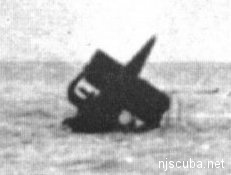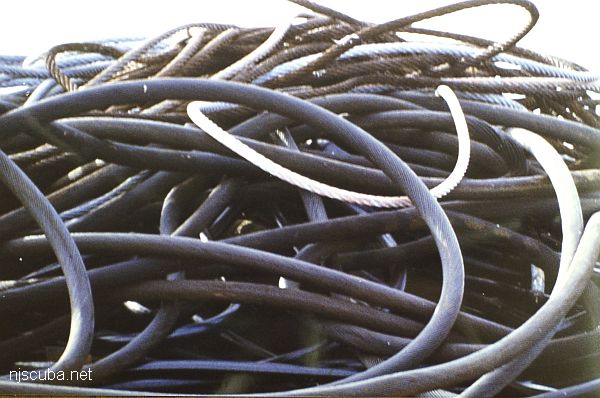USS S-5 SS-110 (2/3)
Keel laid down by the Portsmouth Naval Shipyard, Kittery, ME, 4DEC17;
Launched: 10NOV19; Sponsored by Mrs. Glenn S. Burrell;
Commissioned: 6MAR20 with LCdr Charles M. Cooke, Jr. in command.
Following builder's trials, outfitting, and crew training, USS S-5 (SS-110) departed Boston Navy Yard on 30 August 1920 to undergo full-power trials off the Delaware Capes. On 1 September, as S-5 dove in the afternoon sun, something went terribly wrong. The boat took a sharp down angle and water poured into the boat. The Main Induction valve was supposed to be closed after the engines had stopped rolling and before the valve head just aft of the Conning Tower went underwater. This timing was so important that it was normally the Chief of the Watch's job to do it. An experienced person had to be able to make the judgment. Too early and the engines sucked the air pressure down in the boat, and conserving air was of primary importance in the days before CO2 scrubbers and O2 generators. Too late, and water was sucked down the induction into the boat. It had to be early enough to ensure the boat could blow up quickly if the induction valve didn't shut all the way or leaked badly.
It was a delicate balance. The COB of S-5, GMC Percy Fox, was the man of the hour. He, however, got distracted and was late in shutting the valve. When water started to stream into the boat, he lunged at the lever and - jammed it open! The only way to stop the water was to shut the four individual ventilation line valves in each of the compartments other than the Engine Room (that room's valve was shut on shutting down the engines.) The crew raced to shut the valves and got all of them shut in good order - except the Torpedo Room. That valve would not move. The men in the space abandoned the room, shutting the door and dogging it. The Torpedo Room quickly flooded. The boat had taken on about eighty tons of water through all the ventilation line openings, and had a flooded Torpedo Room. She settled to the bottom in 170 feet of water.

Things looked bad. The boat was tight, true enough, but the crew had no way to get out and could not wait until help arrived, there was not enough air. There was no marker buoy, no escape trunk, no escape lungs - it was not good. The Captain, LCdr Cooke, had a plan, however. He knew the boat was two hundred thirty-one feet long and the water was only one hundred seventy feet deep. If he could pump enough water out of the boat to lift the stern, the boat would pivot on the flooded bow. When it rotated upward enough, the water now in the bilges holding the boat on the bottom could pour through the watertight doors from the Motor Room, to the Engine Room, then to Control, then to the Battery Compartment. This would lighten the stern more, and with just a bit of luck, maybe they could get the stern to stick out so the Motor Room hatch would clear the surface. It would be tough. The hatch center was 178 feet from the bow so, if the boat were standing straight up (90d down-bubble), the hatch would be out of the water, if the bow didn't dig in, if the boat could stand up, if the waves weren't too high, if the depth gauge was accurate, if- if- if. It was worth a try -- actually, it was their only hope.
Timing had to be correct on this one too. The water that would spill forward would go as far as the Torpedo Room bulkhead then start piling as the boat started up. It would soon enter the battery well (it wasn't watertight) and would immediately start producing chlorine gas. The doors had to stay open long enough to let the water spill through, but had to be shut to prevent the gas from contaminating the air, which could not be renewed. If the Battery Compartment door to Control wasn't shut soon enough the chlorine would suffocate the crew, if it were shut too soon, all the water possible would not have drained through and the boat would not tilt up far enough. There was only one chance, they took it.

The aft ballast tanks were blown. The boat remained locked in the grip of the ocean floor mud. The aft normal fuel oil tanks were blown overboard. Slowly, the boat's stern lifted. The water in each compartment slid toward the forward bulkhead of that compartment. Then as the stern lifted more, the water overflowed the bottoms of the doors and cascaded into the next compartment forward. Then everything happened at once. As the boat tilted up, more water poured through each door, loose gear, deck plates, and everything crashed to the forward end of the compartments and sometimes through the doors with the water. Several crew members were washed from their feet or torn away from handholds by the water and the flotsam it carried. A couple went through doors to fall the length of the next compartment as the angle got steeper and steeper. The water in the Battery Compartment got deeper as more water fell from above. Soon those in the space were swimming for their lives to keep their heads above the rising water level.
Now the crew had to climb up an almost vertical submarine hull to go aft. Those in the Battery Compartment had to climb up a rope made of curtains to the aft end of the compartment. The crew evacuated aft to the Control Room. There was now a problem. The Engine Room/Control Room watertight door had slammed shut during the evolution and now had several feet of water on it. In addition, because of the angle on the boat, for the men in Control it was now in the overhead and had to be pushed up to open. With a full load of adrenaline flowing, and with the men in the Engine Room lifting and the men below pushing, the door was opened. More water slammed down from the Engine Room but, when the waterfall stopped, the Control Room could be evacuated. All the men there climbed into the Engine Room. The door was re-shut and dogged.
The manhole cover into the Tiller Room was unfastened and removed. Captain Cooke climbed through along with other crew members. They were mighty pleased to hear the sound of waves against the hull, but it was not enough. Listening and tapping, they found the water level to be about 17 feet from the sternpost. It was not nearly the 52 feet and change necessary to uncover the Motor Room hatch. Now all that stood between them and the open ocean air and escape was three-quarters of an inch of good Bethlehem Steel. A hand drill was found and a quarter-inch hole started. When the hole was finally pushed through, the crew was relieved that a stream of water did not enter.
One of the crew found the 3/8" electric drill in the Engine Room and they went to work on the hull with vigor. Now this drill was not one of the nice plastic-housed double-insulated drills of today. It was metal-cased, not too well insulated, being handled by a wet sailor in wet cloths with his back against a well-grounded hull. The ship's electrical circuits, having long since grounded out, made the job dangerous at best. When the drill was started, some of the current drove the drill, and some drove the man. It was agony. But it was their only hope. Over the course of the next several hours, four holes each about a half-inch in diameter was drilled through the hull. Then the power failed, the lights went out, the drill stopped and there were just the four little holes.

A hacksaw blade was passed through one of the holes and the men started sawing away. By early the next morning, they had cut a hole one-half inch high by four inches long through the hull. The boat had been down for nearly eighteen hours, the air was getting bad, it was hot, damp and the slight amount of chlorine in the air made life just that much worse. The hand drill was pressed into service again and more holes were cut. Captain Cooke looked through the hole and watched as a ship, not more than five miles off, passed by. By the time the boat had been down for 24 hours, the hole had been enlarged to a triangle measuring four inches by six inches. By this time the drill was played out and the crew nearly so.
The captain fastened an undershirt to a 10-foot length of pipe, and stuck it through the hole and started to wave it. He hoped to attract some attention, even though that was a vain hope in the vastness of the sea. Now, luck struck. The steamer SS Alanthus almost didn't, then did, stop. She put a boat over to investigate this mystery. The captain of the Alanthus was a true seaman and when faced with this thing sticking up and a flag-waving, conducted himself and the conversation in a true seaman's manner:
-- "What ship?" he asked with his face near the hole.
-- "USS S-5, " came the reply.
-- "What nationality?" he asked.
-- "American, " came the reply.
-- "Where bound?" he asked.
-- "TO HELL BY COMPASS!!!!!" came the reply.
The Alanthus could not help in cutting the crew out, but rigged a pump to get some air in, and poured cool fresh water into the opening to help cool the crew. She also rigged cables around the stern so it wouldn't slip beneath the surface before help arrived. At about 1800, she attracted a passing Pan-American liner the George W. Goethals. This ship had a radio and called for help. The Navy immediately dispatched two destroyers and the battleship Ohio to the scene. The chief engineer aboard the Goethals decided not to wait for help but to get to work making the hole big enough to get the men out. By 0145, it was big enough to squirm through and the crew started to exit the ship. All thirty-seven crewmen and three of the officers passed out through the hole. By 0300, Captain Cooke had shut and dogged the Motor Room door and left his command.
The Ohio came on the scene shortly afterward and commenced securing heavy towing cables around the protruding stern. As they started a slow tow toward shallow water, the boat bobbed a couple of times, parted the cable, and sank. A salvage attempt was made through November, and then again the following year. The next summer, the Navy called off the effort, and struck S-5 from the Navy List in 1921.
-- from Navy historical records

